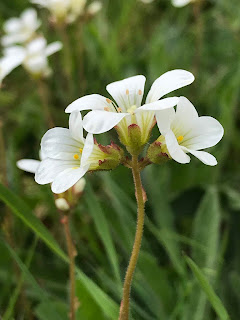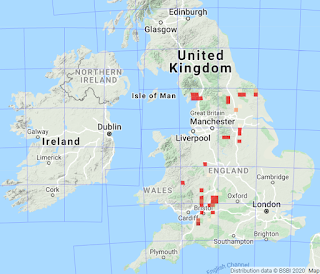 |
| Painting of meadow saxifrage by Deborah Lambkin |
Now a locked-down Kevin tells us about a favourite plant he
managed to find recently while following BSBI guidance about social
distancing and permitted exercise.
Over to Kevin:
“One of my botanical highlights of lockdown was the
discovery of a small population of Meadow Saxifrage Saxifraga granulata on a
riverbank close to my home in Harrogate. This lowland saxifrage is nowhere common;
in my part of North Yorkshire there are probably about a dozen colonies, scattered
on riverbanks, road verges and in the occasional churchyard.
| Meadow saxifrage site near Harrogate Image: K. Walker |
“It is a glorious plant to look at; quite tall for a
saxifrage and with large porcelain-white flowers on long, almost leafless,
hairy stems. It has rather attractive leaves the shape of scallop shells and most
surprising of all it produces tiny red bulbils at the base of the stem; these
are the ‘granulations’ that give the plant its name and form completely new (albeit
genetically identical) plants.
 |
| Meadow saxifrage bulbils Image: K. Walker |
"On road verges it is highly susceptible to mowing,
especially during May including one of my local sites on the verge of a quiet
lane leading to a farm. Only once have I seen it produce flowers when the
farmer missed a small section near to the base of a tree. The same is true of
many churchyards where the grass amongst the graves is kept uniformly short. So
it is heartening to hear that one of our local churchyard colonies, in St
John’s in Sharow near to Ripon, is thriving under a sympathetic mowing regime.
 |
| Meadow saxifrage in St. John's churchyard, Sharow Image: S. Warwick |
"Such schemes are highlighting the huge benefits of letting the grass grow, not
only for wildflowers, but also for other wildlife. This year #NoMowMay, whether
by design or accident, has meant that our urban environments are much more flower-rich
which has benefitted us all during these dark days of lockdown.
 |
| Meadow saxifrage flowers Image: J. Warwick |
"So why had this population of Meadow Saxifrage eluded me for
so long? I had walked that way many times before and, I’m embarrassed to say, I
had even spent a day recording the wildflowers in the same 1 kilometre square.
Maybe it was because you needed to make a special effort to find it. The plants
are tucked away between the stream and a patch of gorse and were only discovered
when we descended to the stream to look for otter prints and to paddle. It’s
also one of our earliest wildflowers to flower, usually in mid-May, and so is
easily overlooked later in the year when most botanical activity takes place.
"But probably the main reason for its discovery is that lockdown
has given us a reason to explore the hidden corners that we ordinarily ignore.
In doing so it has opened our eyes to the beauty and attraction of the commonplace
all around us. And what better way to celebrate this than through the discovery
of wildflowers. As Charles Raven noted during the dark wartime days of the
1940s, “But for an interest
that is always available, which takes you out into the loveliest scenery and
yet can be satisfied in your own backyard, and that continually offers fresh
insight into the beauty and worth of nature, the study of wild plants stands
high.” For many of us, wildflowers have brought some much-needed happiness during
our own dark days and will continue to do so, as we emerge, blinking into the
bright June sunlight".




